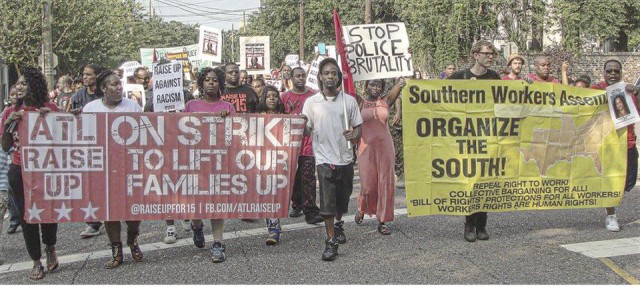‘Days of Grace’ hits racism, poverty
Charleston, S.C.
Over 800 gathered in the city of Charleston, S.C., on the morning of Sept. 5 for the Days of Grace Mass March and Strategy Conference against racism and for economic justice.
Indeed, activists, organizers and attendees traveled from all over the United States. Guest speaker, Clarence Thomas, of the International Longshore Workers Union Local 10, came all the way from Oakland, Calif. Several of their leading organizers all journeyed together from the West Coast to East Coast, including dock workers all the way from Seattle.
The Southern Workers Assembly proved to be one of the most energetic contingents in the march. National activist DeRay McKesson came from Minneapolis, Minn. Organizers with the Fight for $15 pressed their way from as far as Alabama, Georgia, North Carolina, Virginia and Tennessee. The Boston-based Mass Action Against Police Brutality came all the way from Massachusetts. Workers World Party sent a delegation representing Durham, N.C., Virginia, Atlanta, Los Angeles and New York. Such solidarity was an affirmation of our collective sense of urgency.
As old and young, Black and white, women and men stood together, we remembered the fallen nine of Emanuel African Methodist Episcopal Church in strength and solidarity, innocent victims of the racist shooting spree on June 17. We lifted the name of Walter Scott, fatally shot in the back by a cop in North Charleston, in the name of justice, truth and liberation. We honored the countless victims of police terror and continued state violence, nationwide. As nearly a thousand marched through downtown Charleston, our display of unity, resistance and sheer determination could not be ignored. Our will to fight could not help but be heard as tourists and onlookers took note. National media sources kept pace and stayed close.
As you looked over the crowd, there were placards and banners commemorating the work and sacrifices of Denmark Vesey, Robert Smalls and Harriet Tubman — all anti-slavery fighters. Slogans such “Finish the revolution,” “Stop the war on Black America,” and “Black women matter” were all fan favorites. Along the march, local ministers sang “We Shall Overcome,” while more militant-minded youth chanted “Black Power!” and “No justice, no peace!” As the morning sun began to rise, we concluded with an enthusiastic and thunderous rally on Marion Square.
Key issues included police terror and discriminatory enforcement; the minimum wage and the exploitation of low-wage workers; health care, public education, collective bargaining and new strategies toward achieving Black liberation. It was quite refreshing to see such a wide range of local and national organizations actually working together, very intentionally setting their differences aside for the sake of poor, working-class and oppressed communities.
Keynote speaker, the Rev. William Barber, president of the North Carolina NAACP, took attendees to the mountaintop of truth and grace. “We’re in the embryonic stages of the third reconstruction,” Barber said, noting that many of the same issues from 100 years ago are still with us today. “The first consciousness we have to change is the consciousness of the people,” he said, noting that it will take a mass movement to move state legislatures to win progressive concessions for the oppressed.
Clarence Thomas gave a stirring speech calling for workers to shut down the economy, mentioning the recent May Day shutdown of the docks on the West Coast.
Though supporters of presidential candidate Bernie Sanders were in attendance, guest speakers and conference organizers reminded the people that neither Republicans nor Democrats will grant the poor and working class genuine people power — a valid point that was carefully articulated later in the day.
A solidarity message from the National Network on Cuba was read from the stage.
Working-class unity not usually seen in the South
Following the march was a mass convening at the International Longshoremen Association Hall on Morrison Drive that hosted workshops, vendors and teach-ins. Angaza Laughinghouse, Vice-President of the United Electrical Workers Local 150 and Black Workers for Justice, led a session discussing the economic plight of Southern workers who are mostly un-unionized and without collective bargaining.
Local Black Lives Matter organizer Muhiyyidin d’Baha conducted a teach-in on “Strategizing Against Police Terror.” T-shirts bearing the images of Denmark Vesey and the 1739 Stono Rebellion, the largest rebellion in the colonies led by slaves outside Charleston, were quite inspiring.
During the Sept. 6 final plenary, Ajamu Dillahunt, long-time organizer with Black Workers for Justice, reminded us, “This march was very unique. We had the Civil Rights Movement, the Black Power Movement, Black Lives Matter and the Fight for $15.” Dillahunt was absolutely correct. This brand of working-class unity is something the U.S. South hasn’t seen for decades.
Though the number of attendees was a little lighter than expected, it’s very important to note that most of the organizers and participants were actually based in the Southeast (the Southern Black Belt). That development will only aid in the process of organizing. Connections were made and meaningful relationships were able to be established. The Days of Grace were only the start. Revolution is the next step forward.






